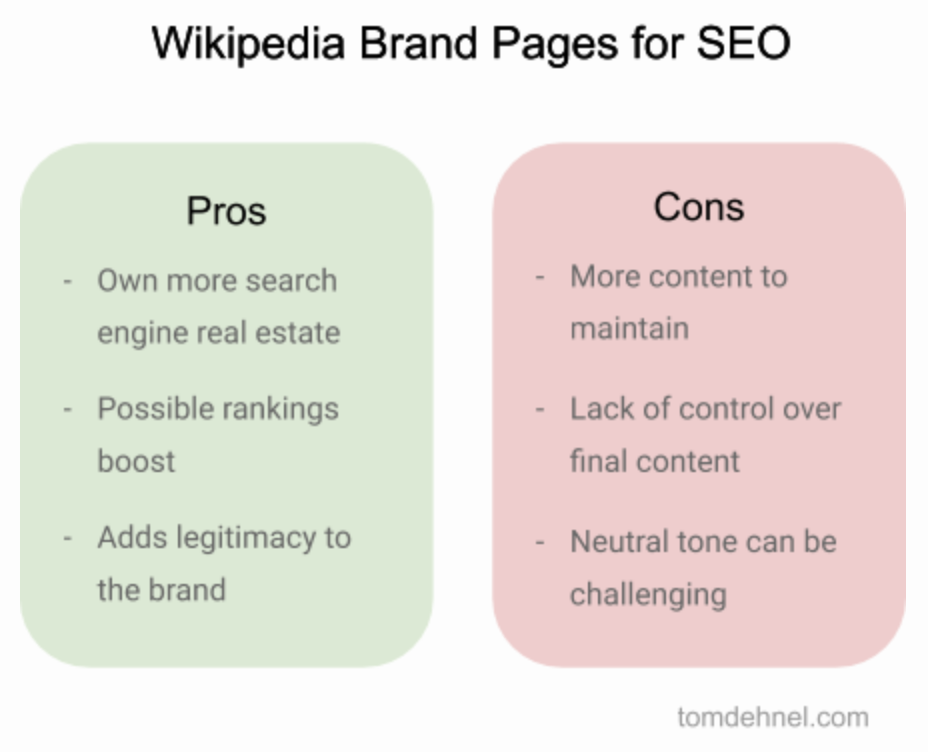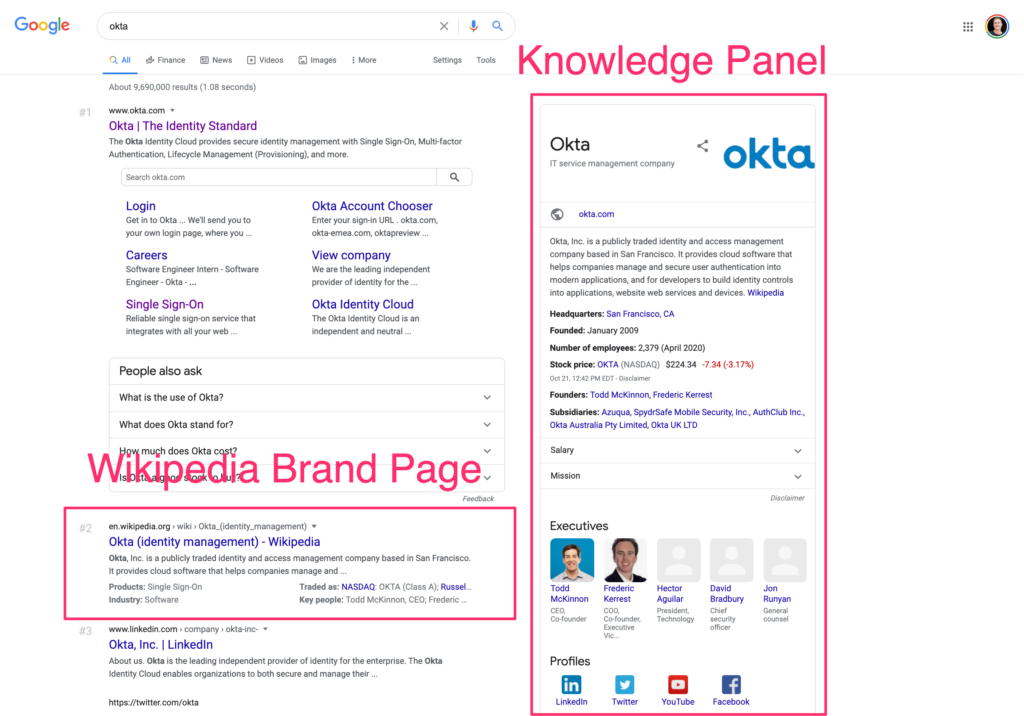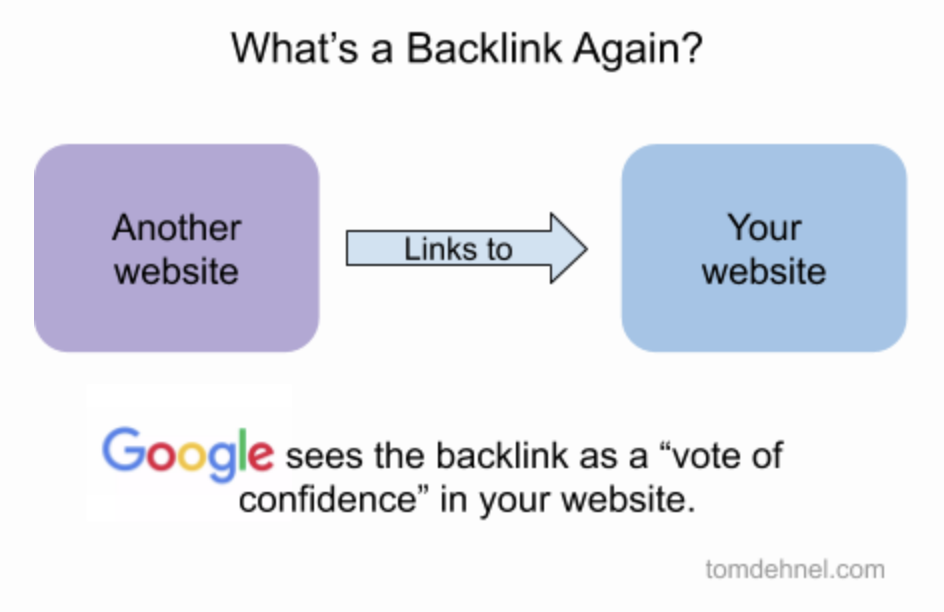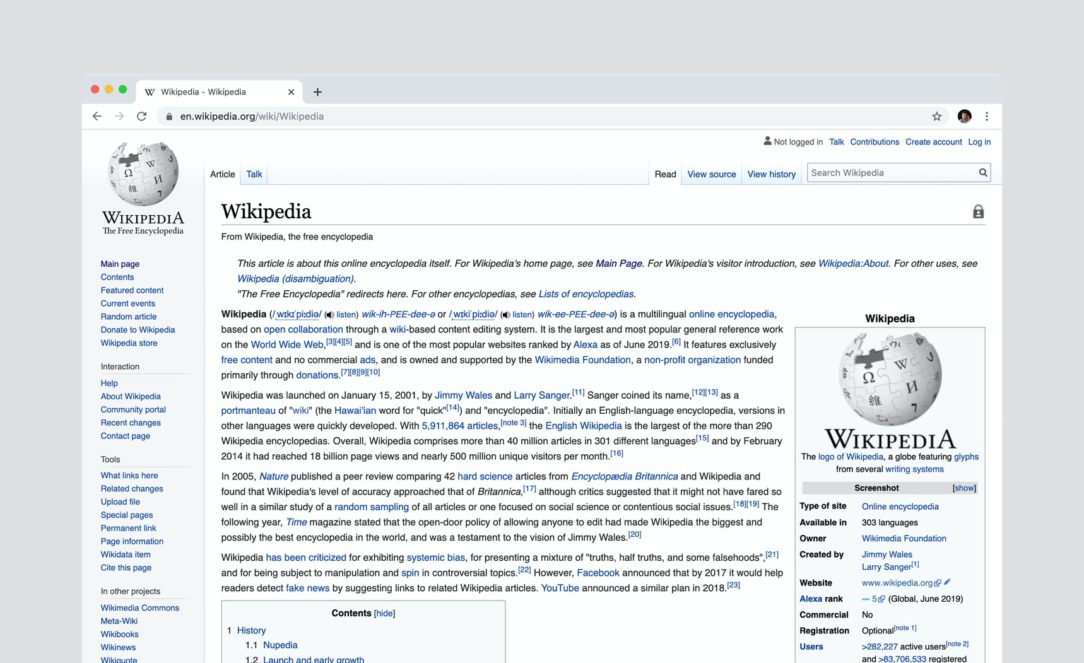I’ve been asked a couple of times by clients whether they should make a Wikipedia page for their brand. Usually, they want to know if a Wikipedia page will be a good thing for SEO.
Like most SEO questions, the answer is it depends. But generally speaking, I think Wikipedia pages are worth focusing some time on, as long as you’re aware of the upsides and downsides.

I’ll go into more detail below about each of these Wikipedia page advantages and disadvantages for SEO.
Advantages of Wikipedia Pages for SEO
Own more Search Engine real estate
Wikipedia is one of the most trusted, authoritative, sites on the whole internet. At this point, you can search for pretty much any topic and you’ll see a Wikipedia entry on page 1.
That means your Wikipedia page is likely to rank on page 1 when people search for your brand name. Your Wikipedia page will effectively “push” 3rd-party sites (like review aggregators or industry publishers) further down or off the page. This can be especially useful in cases where brands are looking to get rid of bad press, reviews, or otherwise manage their reputation online.
Having a Wikipedia brand page also gives Google a wealth of information to add to their Knowledge Graph. That usually results in a more robust Knowledge Panel, effectively branding the SERP with your logo and company information.

Possible rankings boost
Any SEO person will tell you that earning backlinks from authoritative websites is one of the best ways to improve your site’s rankings. That’s because links from trusted websites are one of the strongest ranking signals used by Google’s Search algorithms.

Wikipedia is one of the most trusted websites on the internet. So backlinks from Wikipedia should be super valuable, right?
Not so fast, there’s a catch. Links from Wikipedia pages are automatically tagged with the nofollow attribute.
It used to be that Google would not count any nofollow link as a positive signal for their search algorithms. But, as of March 2020, Google is officially treating the nofollow link attribute as a hint (instead of a directive), for crawling and indexing.
This doesn’t directly confirm whether Google places value on nofollow links from Wikipedia, but it doesn’t totally rule it out.
In my view, Google likely sees Wikipedia as a good source of information, and there is probably some value to having links to your site’s pages from Wikipedia. Those links are probably going to be more or less valuable depending on how relevant the destination page is to the page doing the linking.
Legitimacy
This is a simple one. Most established brands have Wikipedia pages. People searching for information about your company using its brand name will see a Wikipedia page as a sign that the brand is well-established online. It’s a unique opportunity to do something to help when people are looking for your company using branded search keywords.
Disadvantages of Wikipedia Pages for SEO
More content to maintain
A Wikipedia page is another place you’ll need to manage content. And since it will probably show up on Page 1 of the search results, it’s likely to draw attention from senior people at your company.
If content typically takes a long time to review internally at your company, the process of getting approval for proposed changes to your brand’s Wikipedia page could be time consuming (and annoying).
Lack of control over final content
Even if long approvals are the norm at your company, at least the lengthy review process is finished when content is published. Not on Wikipedia.
The beauty of Wikipedia is that anyone can create an editor account and publish whatever they like. But you should be prepared for the site’s community of editors to change or even delete content you post if they feel it’s not in line with Wikipedia’s policies.
Other Wikipedians could add whatever they want to your brand page. If the Wikipedia community deems that information relevant to your brand, you’ll have a hard time getting it off your page.
Neutral tone
Creating content for Wikipedia is hard enough, but brands looking to build out or edit their own brand page should be especially wary of Wikipedia’s neutrality policy, which states that “all content must be written from a neutral point of view (NPOV)…without editorial bias.”
This pretty much flies in the face of most marketing content, and it’s supremely difficult for founders, executives, and marketing people to have a neutral point of view about the company they work for.
“It is difficult to get a man to understand something when his salary depends upon his not understanding it.” – Upton Sinclair
Take Coca-Cola, for example. Here are some of the taglines their marketing folks have been touting through the years, some of which have been true classics:
- Pure as sunlight, around the corner from everywhere
- Makes good things taste better
- It’s the real thing
- Always Coca-Cola
- Taste the feeling
But the very first sentence of the Wikipedia brand page for Coca-Cola says it’s “a carbonated soft drink manufactured by The Coca-Cola Company.” You definitely can’t “taste the feeling” in that sentence, but that’s what the Wikipedia community is willing to accept.
So keep in mind that you may need to set these expectations with marketing and senior leadership:
- Pursuing a Wikipedia brand page means playing by Wikipedia’s rules.
- Your Wikipedia brand page isn’t the place to focus on conversions or your latest marketing message.
So, Brand Wikipedia Pages…a Good Idea?
Generally yes, I think it’s a good idea for a brand to try and make a Wikipedia page. But keep in mind you’ll have a few hurdles to jump over. The best advice I can give is to:
- Share your plan early with marketing and executive leadership. Let them know ahead of time about the benefits, but also the challenges you might face.
- If you’re creating a new page, follow Wikipedia’s suggested lifecycle, including writing a solid new page proposal.
- Work hard to maintain a neutral tone, and be prepared for edits.
That’s it! If you liked this article I don’t have a newsletter to subscribe to, but you can find some other SEO-related writing here on my site.

I run a small SEO consulting business in San Francisco, CA. I like to write a little bit and get in arguments with my friends. It’s the only way I can make sense of the world.
